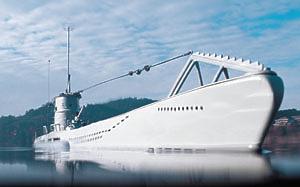|
We all know that technology is always being expanded and
improved every- day. Well, the same thing goes for submarine models, especially RC ones, ( or remote-controlled ) which involves
both knowledge in electronics, mechanics and obviously, modelling.
Here is what we know as RC Sub basics, up to date:
Diving Methods
Well, this is probably, the first question we usually ask,
how do they actually dive and surface? To answer the question correctly, there are two main ways that RC subs use to dive
they are:
This is the safest method available, and quite simple
too. Submarines which use this method uses diving planes and their speed to actually push the sub underwater, and since no
ballast is applied, the sub must have a positive buoyancy ( in other words, it has to be well balanced or otherwise, if one
end is heavy and one end is light, your sub is pretty much weird looking and "unsurfacable" ). Therefore, if you stop the
motor, the sub will rise again, you can take advantage of this if there is any battery failure or electronic problems.
To sum up the idea, the advantage of this method
is that it is simple, safe and in case of a problem, just stop the motor and let your sub rise! The disavantage with this
system is that if we placed a camera just below the waterline, looking at the sub at a profile view, we would see the
sub diving at a diagonal angle, which is not like a real sub ( they do use this method, on a larger scale, in an emergency
dive I think ) which uses ballast tanks to change the weight of the craft and weights the sub down, into the water. Vertically,
which leads us to our next topic:
This method is rather different from the
previous method explained. When we think of "static", we think of "not moving"( as in Static Modelling ), which means that
subs with this this diving method actually use mini ballast tanks ( well, depending on the size of the sub ) to take the water
in and out of the the sub through the hull just like the real ones. The static diving subs tends to be more complex and
require more experience in the subject of RC submarines, they are usually more expensive and require more radio
components, such as extra channels and more electronics.
The good thing about this kind of subs is that
when they dive, they tend to look more realistic and adds more twist to the hobby. The bad thing is that if they accidentally
fail to suface and does not respond to your commands, your sub is maybe down to the bottom. Therefore, you MUST have a failsafe
if you're choosing to build a sub of this kind, they either blow ballast, or release some sort of signal, ( floating buoy,
flag, etc ) to mark the place where your sub was last seen ( as featured in my RC Nautilus ). But don't worry, few subs I
know were sunk this way, and their owners usually succeeds in rescuing their sub.
So in conclusion, either way you want to choose your
sub to be, be sure you have a very good sealing system, failsafe, and other important parts.
Here are
some examples of Static and Dynamic diving subs:

|
| The Robbe U-47 |
The Robbe U-47 is an excellent example of a dynamic diving
sub, it measures around 1.7m and costs around $475 U.S. without RC components, available at http://www.subconcepts.com.
Wanna find out more about RC subs? Click on one of these topics below:
|

